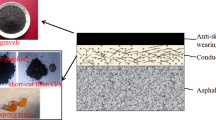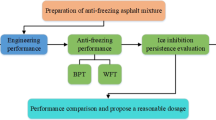Abstract
It is known that the freezing of the road brings high risks to the traffic in winter. However, Traditional deicing technology has low deicing efficiency and severe damage to the road surface. Therefore, the new develop pavement conductive wearing surface with graphite heating film (PCWSG) could be one option to solve this problem. So the main objective of this paper is to investigate the road performance (high-temperature, low-temperature, moisture susceptibility, friction-resistance) of pavement conductive wearing surface with graphite heating film (PCWSG) and then evaluate its deicing potential. In this paper, several tests are conducted to evaluate the performance of PCWSG. The high-temperature performance is conducted by the laboratory wheel-tracking rut test. Low-temperature performance is characterized by the low-temperature bending test. Moisture susceptibility is studied by the freeze-thaw split test. Friction-resistance performance is estimated by the pendulum type friction coefficient measuring instrument and the small acceleration loading device. Furthermore, removing ice potential is studied by asphalt rutting slabs (various gradations) with graphite conductive wearing surface. The results show that pavement conductive wearing surface with graphite heating film (PCWSG) could improve the high-temperature, low-temperature, and friction-resistance compared with the original asphalt mixture. Although moisture susceptibility and wear performance decrease lightly but also satisfy the specification requirement. Moreover, removing ice potential of asphalt slabs with PCWSG results shows that AC-20 asphalt concrete with higher porosity has better deicing and snow removal effect. The PCWSG has lower heating and deicing cost and more effective deicing effects.
Similar content being viewed by others
References
H. C. Dan, J. W. Tan, Y. F. Du, J. M. Cai, Simulation and optimization of road deicing salt usage based on Water-Ice-Salt Model, Cold Regions Sci. Technol. 169 (2020) 102917.
K. Wang, D. E Nelsen, A. Wilfrid, Damaging effects of deicing chemicals on concrete materials, Cem. Concr. Compos. 28 (2) (2006) 173–188.
D. Sanzo, S.J.J.E.P. Hecnar, Effects of road de-icing salt (NaCl) on larval wood frogs (Rana sylvatica), Environ. Pollution 140 (2) (2006) 247–256.
S. Wu, Investigation on Microwave Heating Technology for Rutting Maintenance in Asphalt Pavement, J. Test. Eval. 48 (2020) (4).
J. R. Chang, W.J. Steyn, D. H. Chen, Special Issue on Civil Infrastructure: From Failure to Sustainability, J. Performance Constr. Facil. (2018) https://doi.org/10.1061/%28ASCE%29CF.1943-5509.0001087
F. Yang, F. Yang, K. Li, R. Xiong, B. Guan, & Zhao, H., Investigation on Deicing Property of Steel Wool Fiber-Reinforced Asphalt Mixture by Induction Heating, Adv. Mater. Sci. Eng. (2020) https://doi.org/10.1155/2020/5250628.
A. Shishegaran, F. Daneshpajoh, H. Taghavizade, S. Mirvalad, Developing conductive concrete containing wire rope and steel powder wastes for route deicing, Constr. Build. Mater. 232 (2020) 117184.
T. Che, B. Pan, J. Ouyang, The laboratory evaluation of incorporating ceramsite into HMA as fine aggregates, Constr. Build. Mater. 186 (2018) 1239–1246.
D. Derwin, P. Booth, P. Zaleski, W. Marsey, et al., Heated Pavement System to Eliminate Icy Runways. No. 2003-01. SAE Technical Paper Series. Report (2003) https://doi.org/10.4271/2003-01-2145
W. Shao-peng, L. Mo, S. He, D. Xuan, Y. Xue, W. Yang, An improvement in electrical properties of asphalt concrete. J. Wuhan University of Technology-Mater. Sci. Ed. 17 (4) (2002) 69–72.
S. P. Wu, X. M. Liu, Q. S. Ye, L. I. Ning, Self-monitoring electrically conductive asphalt-based composite containing carbon fillers, Transactions Nonferrous Metals Soci. Chin. 16 (2006) s512–s516.
S. Wu, L. Mo, Z. Shui, Z. Chen, Investigation of the conductivity of asphalt concrete containing conductive fillers. Carbon 43 (7) (2005) 1358–1363.
S. Wu, P. Pan, M. Chen, Y. Zhang, Analysis of characteristics of electrically conductive asphalt concrete prepared by multiplex conductive materials, J. Mater. Civ. Eng. 25 (7) (2013) 871–879.
D. Ge, Z. You, S. Chen, C. Liu, J. Gao, S. Lv, The performance of asphalt binder with trichloroethylene: improving the efficiency of using reclaimed asphalt pavement, J. Clean. Prod. 232 (2019) 205–212.
S. Wu, J. Yang, X. Sun, C. Wang, R. Yang, J. Zhu, Preparation and characterization of anti-freezing asphalt pavement, Constr. Build. Mater. 236 (2020) 117579.
S. Chen, Z. You, N. P. Sharifi, H. Yao, F. Gong, Material selections in asphalt pavement for wet-freeze climate zones: A review, Constr. Build. Mater. 201 (2019) 510–525.
S. Chen, F. Gong, D. Ge, Z. You, J. B. Sousa, Use of reacted and activated rubber in ultra-thin hot mixture asphalt overlay for wet-freeze climates, J. Clean. Prod. 232 (2019) 369–378.
H. Yu, Z. He, G. Qian, X. Gong, X. Qu, Research on the anti-icing properties of silicone modified polyurea coatings (SMPC) for asphalt pavement, Constr. Build. Mater. 242 (2020) 117793.
Á. García, E. Schlangen, M. van de Ven, Q. Liu, Electrical conductivity of asphalt mortar containing conductive fibers and fillers, Constr. Build. Mater. 23 (10) (2009) 3175–3181.
X. Liu, S.J.C. Wu, Study on the graphite and carbon fiber modified asphalt concrete, Constr. Build. Mater. 25 (4) (2011) 1807–1811.
M. Pour-Ghaz, J.J.C. Weiss, Detecting the time and location of cracks using electrically conductive surfaces, Cem. Concr. Compos. 33 (1) (2011) 116–123.
M. Pasetto, N.J.J.o.h.m. Baldo, Experimental evaluation of high performance base course and road base asphalt concrete with electric arc furnace steel slags, J. Hazard. Mater. 181 (1–3) (2010) 938–948.
W. Thongruang, R.J. Spontak, C.M.J.P. Balik, Correlated electrical conductivity and mechanical property analysis of high-density polyethylene filled with graphite and carbon fiber, Polymer 43 (8) (2002) 2279–2286.
Y. Liu, X. Zhou, Z. You, S. Yao, F. Gong, H. Wang, Discrete element modeling of realistic particle shapes in stone-based mixtures through MATLAB-based imaging process, Constr. Build. Mater. 143 (2017) 169–178.
A. Farina, M.E. Kutay, M. Lanotte, Laboratory and field performance investigation of pre-swollen crumb rubber modified asphalt mixtures, Inter. J. Pavement Res. Technol. (2020) https://doi.org/10.1007/s42947-020-0191-0
A.M. Alnadish, M. Y. Aman, H. Y. B. Katman, M. R. Ibrahim, Laboratory assessment of the performance and elastic behavior of asphalt mixtures containing steel slag aggregate and synthetic fibers, Inter. J. Pavement Res. Technol. (2020) https://doi.org/10.1007/s42947-020-1149-y
C. Si, X. Zhou, Z. You, Y. He, E. Chen, R. Zhang, Micromechanical analysis of high modulus asphalt concrete pavement, Constr. Build. Mater. 220 (2019) 128–141.
J. Gao, P. Liu, Y. Wu, Y. Xu, H. Lu, Moisture damage of asphalt mixture and its evaluation under the long-term soaked duration, Inter. J. Pavement Res. Technol. 2020) 1–8.
T. Mandal, C. Ling, P. Chaturabong, H. U. Bahia, Evaluation of analysis methods of the semi-circular bend (SCB) test results for measuring cracking resistance of asphalt mixtures, Inter. J. Pavement Res. Technol. 12 (5) (2019) 456–463.
R. Vaiana, F. Praticò, Pavement surface properties and their impact on performance-related pay adjustments. in Proceedings of the 3rd International Conference on Tranportation Infrastructure, Pisa, Italy, 2014.
A. Susanna, M. Crispino, F. Giustozzi, E. Toraldo, Deterioration trends of asphalt pavement friction and roughness from medium-term surveys on major Italian roads, Inter. J. Pavement Res. Technol. 10 (5) (2017) 421–433.
J. R. Chang, K. T. Chang, D. H. Chen, Application of 3D laser scanning on measuring pavement roughness, J. Test. Eval. 34 (2) (2006) 83–91.
Acknowledgment
This work is supported by the Key Research and Development Foundation Project of Shandong under Grant 2017GSF220008.
Author information
Authors and Affiliations
Corresponding author
Additional information
Peer review under responsibility of Chinese Society of Pavement Engineering.
Rights and permissions
About this article
Cite this article
Yan, Z., Liu, W., Chen, J. et al. Pavement conductive wearing surface with graphite heating film de-icing potential and performance experimental study. Int. J. Pavement Res. Technol. 14, 688–696 (2021). https://doi.org/10.1007/s42947-020-0263-1
Received:
Revised:
Accepted:
Published:
Issue Date:
DOI: https://doi.org/10.1007/s42947-020-0263-1




